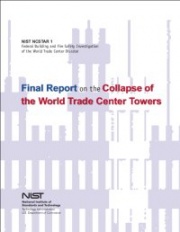NIST
Aus 9/11 Wiki
| Zeile 16: | Zeile 16: | ||
"The focus of the investigation was on the sequence of events from the instant of aircraft impact to the initiation of collapse for each tower. For brevity in this report, this sequence is referred to as the 'probably collapse sequence,' although it does not actually include the structural behavior of the tower after the conditions for collapse initiation were reached and collapse became inevitable." (S. 82) | "The focus of the investigation was on the sequence of events from the instant of aircraft impact to the initiation of collapse for each tower. For brevity in this report, this sequence is referred to as the 'probably collapse sequence,' although it does not actually include the structural behavior of the tower after the conditions for collapse initiation were reached and collapse became inevitable." (S. 82) | ||
| + | |||
| + | Aus einem NIST-FAQ: [Frage:] „Hat die NIST-Untersuchung nach Hinweisen darauf gesucht, | ||
| + | dass die WTC-Türme durch eine kontrollierte Sprengung zu Fall gebracht worden sein könnten? | ||
| + | Wurde der Stahl auf Sprengstoff- oder Thermitrückstände getestet? | ||
| + | Die Kombination von Thermit und Schwefel (Thermat genannt)‚ schneidet durch Stahl wie ein heißes | ||
| + | Messer durch Butter’.“ | ||
| + | [Antwort:] „NIST hat den Stahl nicht auf Rückstände dieser Verbindungen getestet“ [3]. | ||
| + | |||
| + | |||
| + | |||
'''Weblinks''' | '''Weblinks''' | ||
| Zeile 24: | Zeile 34: | ||
'''Quellen''' | '''Quellen''' | ||
#NIST NCSTAR 1: Federal Building and Fire Safety Investigation of the World Trade Center Disaster: Final Report of the National Construction Safety Team on the Collapses of the World Trade Center Tower -- NIST, September 2005 (PDF) | #NIST NCSTAR 1: Federal Building and Fire Safety Investigation of the World Trade Center Disaster: Final Report of the National Construction Safety Team on the Collapses of the World Trade Center Tower -- NIST, September 2005 (PDF) | ||
| + | |||
| + | |||
| + | [3] S. Sunder, W. Grosshandler, H. S. Lew, et al. “National Institute of Standards and Technology | ||
| + | (NIST) federal building and fire safety investigation of the World Trade Center disaster, answers to | ||
| + | frequently asked questions”, Gaithersburg, MD: | ||
| + | National Institute of Standards and Technology, August 30, 2006. [Online]. Available: NIST, http:// | ||
| + | wtc.nist.gov. [Accessed March 17, 2008]. | ||
| + | |||
[[Kategorie:Offizielle Untersuchungsorgane]] | [[Kategorie:Offizielle Untersuchungsorgane]] | ||
Version vom 14. September 2010, 09:56 Uhr
Das National Institute of Standards and Technology (NIST) veröffentlichte seinen Final Report on the Collapse of the World Trade Center Towers (NCSTAR 1) im September 2005. Daneben gibt es noch 42 Einzeluntersuchungen zu bestimmten Themen.
Aussagen aus NIST NCSTAR 1: Zitate aus dem offiziellen Report:
"The WTC towers likely would not have collapsed under the combined effects of aircraft impact damage and the extensive, multi-floor fires that were encountered on September 11, 2001, if the thermal insulation had not been widely dislodged or had been only minimally dislodged by aircraft impact." (S. xxxviii)
"None of the recovered steel samples showed evidence of exposure to temperatures above 600 degrees C for as long as 15 minutes." (S. 180)
"Only three of the recovered samples of exterior panels reached temperatures in excess of 250 degrees C during the fires or after the collapse. This was based on a method developed by NIST to characterize maximum temperatures experienced by steel members through observations of paint cracking." (S. 181)
"All four test specimens sustained the maximum design load for approximately 2 hours without collapsing…" (S. 143)
"The results established that this type of assembly was capable of sustaining a large gravity load, without collapsing, for a substantial period of time relative to the duration of the fires in any given location on September 11." (S. 143)
"The focus of the investigation was on the sequence of events from the instant of aircraft impact to the initiation of collapse for each tower. For brevity in this report, this sequence is referred to as the 'probably collapse sequence,' although it does not actually include the structural behavior of the tower after the conditions for collapse initiation were reached and collapse became inevitable." (S. 82)
Aus einem NIST-FAQ: [Frage:] „Hat die NIST-Untersuchung nach Hinweisen darauf gesucht, dass die WTC-Türme durch eine kontrollierte Sprengung zu Fall gebracht worden sein könnten? Wurde der Stahl auf Sprengstoff- oder Thermitrückstände getestet? Die Kombination von Thermit und Schwefel (Thermat genannt)‚ schneidet durch Stahl wie ein heißes Messer durch Butter’.“ [Antwort:] „NIST hat den Stahl nicht auf Rückstände dieser Verbindungen getestet“ [3].
Weblinks
- Final Reports of the Federal Building and Fire Investigation of the World Trade Center Disaster (NCSTAR 1 bis 1-8)
Quellen
- NIST NCSTAR 1: Federal Building and Fire Safety Investigation of the World Trade Center Disaster: Final Report of the National Construction Safety Team on the Collapses of the World Trade Center Tower -- NIST, September 2005 (PDF)
[3] S. Sunder, W. Grosshandler, H. S. Lew, et al. “National Institute of Standards and Technology
(NIST) federal building and fire safety investigation of the World Trade Center disaster, answers to
frequently asked questions”, Gaithersburg, MD:
National Institute of Standards and Technology, August 30, 2006. [Online]. Available: NIST, http://
wtc.nist.gov. [Accessed March 17, 2008].
